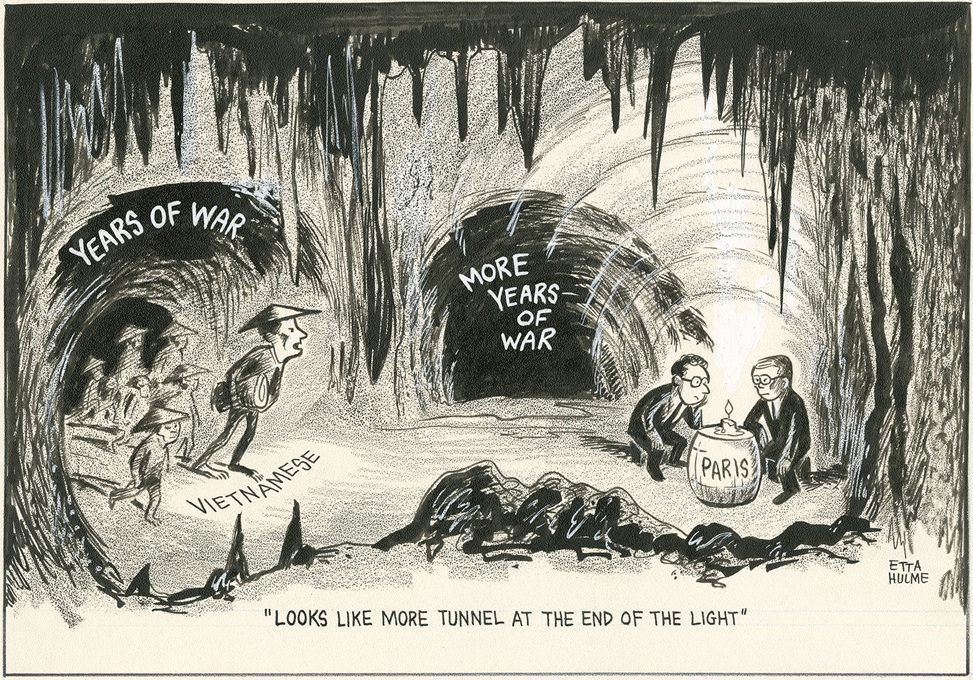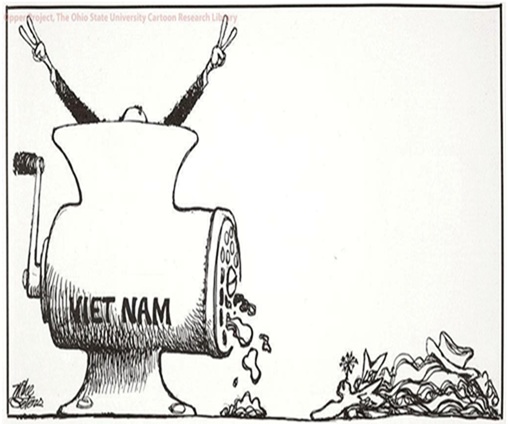|
|
|
|
Source A
A cartoon about the Paris peace talks by the respected editorial cartoonist Etta Hulme for an American daily newspaper. It is dated 10 January 1973.
|
Going DeeperThe following links will help you widen your knowledge: Basic accounts from BBC Bitesize and Clever Lili The Paris Peace Accords - in more detail
YouTube The Paris Peace Accords - Encyclopaedia Britannica Paris Peace Accords - Mr Cloke
|
|
The Paris Peace TalksPeace talks had begun with the end of the Tet Offensive in May 1968, but it soon became clear to Henry Kissinger, Nixon’s National Security Advisor, that both sides were using the Talks – which were being held in public – for public posturing, not for meaningful talks. Kissinger was famous for his ‘shuttle diplomacy’ – going to and fro between all the different parties, advancing negotiations one small step at a time. He therefore abandoned the public meetings, and asked to speak privately with Le Duc Tho, the Politburo member who was Head of the DRV (Democratic Republic of Vietnam – North Vietnam) Delegation. Over the next four years the two met 68 times in 27 rounds of negotiations. For three years, Le Duc Tho held fast to the DRV position demanding unconditional US withdrawal and the abandonment of the Thieu government, and rejecting Kissinger’s proposals for a mutual withdrawal of military forces and elections in South Vietnam. In March 1972, the DRV again tried a military solution, launching their Easter Offensive, but by October it had been driven back, mainly as a result of the massive US ‘Operation Linebacker’ bombing campaign; the DRV realised that they could not win the war while the US was in Vietnam. The Easter Offensive, however, had also convinced the US that this was an unending, unwinnable war. Kissinger offered concessions – a ceasefire instead of NVA withdrawal, and total American withdrawal from South Vietnam. In return, the DRV offered its own concession: to recognise the government of South Vietnam. In October 1972 Kissinger announced that ‘peace was at hand’ in Vietnam. Suddenly, negotiations stalled. The South Vietnamese President Nguyen Thieu – fearing that the Americans were abandoning him – refused to accept the terms of the ceasefire (his position was the ‘policy of the Four NOs’ – no talks, no shared government, no reforms, no surrender’). The DRV therefore also left the negotiating table. Over Christmas 1972, Nixon let loose his ‘madman in the White House’ policy, dropping more bombs on North Vietnam in 11 days than in all the years 1969-71. At the same time he told Thieu that America was signing with or without him, but would give him financial support if he agreed. Negotiations resumed, and the Paris Peace Accords were signed on 27 January 1973. The treaty agreed a ceasefire and the withdrawal of US forces, along with the return of all Prisoners of War, after which direct talks would be held between North and South Vietnam for a political settlement. The last American troops left Vietnam on 29 March 1973.
|
Source B
A cartoon which appeared in a local newspaper in Ohio, America in 1971. In this cartoon, President Nixon is being consumed by a meat grinder labelled Vietnam. The pile on the right represents the remains of Lyndon Johnson after being destroyed by the same meat grinder.
Did You KnowAt first the deiplomats could not even agree the shape of the tables to be used at the conference. The North wanted a circular table, to show equality. The South Vietnamese demanded a rectangular table to show the two sides to the conflict. Eventually a compromise was reached, in which the Vietnamese (North & South) sat round a circular table, with all other parties at square tables around them..
|
|
The Collapse of South VietnamThieu renounced the Accords and began to try to drive the NVA out of South Vietnam. In response, the DRV issued its commanders the ‘Five Forbids’ – Don’t attack, don’t resist enemy attacks, don’t surround enemy positions, don’t shell enemy positions, don’t construct defences … but local NVA-VC commanders ignored their orders. The next two years, therefore, were taken up by the ‘Cease-fire War’ in South Vietnam. Although the US funded the ARVN, with the Americans (and their money) gone, the South Vietnamese economy failed. In April 1974, Thieu asked for more economic aid – instead the American Congress reduced it. The South Vietnamese were on their own. In March 1975, the NVA invaded South Vietnam; the ARVN retreated faster that the NVA could advance. Thieu resigned, and on 30 April 1975 Communist troops marched victoriously into Saigon (which they renamed Ho Chi Minh City) as the last Americans were frantically helicoptered out. Congress refused a request by the new President, Gerald Ford, for a $722 million aid package – Ford’s response was to announce that the war was over.
|
Source CI left Hanoi with determination [to make the peace work] rather than optimism [that it would]. Henry Kissinger, Ending the Vietnam War (2003).
Source DAt last Vietnam was united and free – under a communist government. In the same year, communist governments were also established in Laos and Cambodia. American policy of preventing the spread of communism in south-east Asia had ended in complete failure and humiliation. Norman Lowe, Mastering Modern World History (1988).
|
|
Source EThroughout these negotiations, I insisted on peace with honour. In the agreed settlement, all the conditions I demanded have been met. The Vietnamese people have been guaranteed the right to decide their own future. The President of South Vietnam fully supports this agreement. Let us be proud that America did not agree a peace settlement that betrayed its allies. We will continue to give aid to South Vietnam and support its efforts to settle its problems peacefully. From a speech made by President Richard Nixon, 23 January 1973, describing the Paris peace talks.
|
Source FWhen I read what had been agreed at the Paris talks, I knew that America was betraying South Vietnam. My South Vietnamese friends said, ‘Has your government agreed this? Our lives are finished. Our country is gone.’ They knew we had let them down and it badly weakened their confidence and determination. I knew there would soon be a major North Vietnamese attack and that the South Vietnamese government would collapse . From an interview with an American who had been an official in Saigon in 1972, published in 1985.
|
|
Consider
|
|
|
|
|
||
|
Spotted an error on this page? Broken link? Anything missing? Let me know. |
| |

